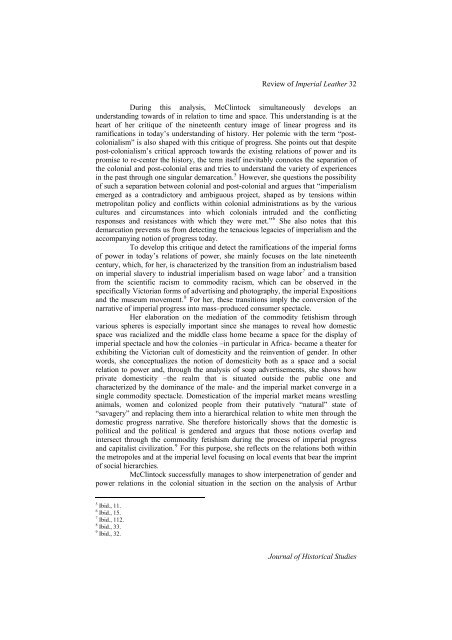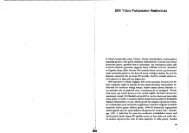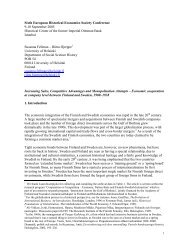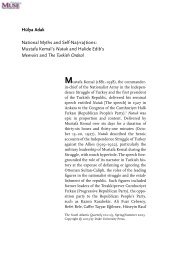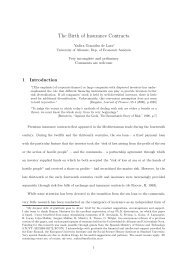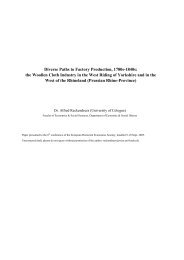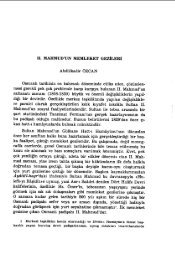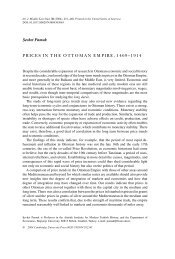Anne McClintock, Imperial Leather - The Ataturk Institute for Modern ...
Anne McClintock, Imperial Leather - The Ataturk Institute for Modern ...
Anne McClintock, Imperial Leather - The Ataturk Institute for Modern ...
You also want an ePaper? Increase the reach of your titles
YUMPU automatically turns print PDFs into web optimized ePapers that Google loves.
Review of <strong>Imperial</strong> <strong>Leather</strong> 32<br />
During this analysis, <strong>McClintock</strong> simultaneously develops an<br />
understanding towards of in relation to time and space. This understanding is at the<br />
heart of her critique of the nineteenth century image of linear progress and its<br />
ramifications in today’s understanding of history. Her polemic with the term “postcolonialism”<br />
is also shaped with this critique of progress. She points out that despite<br />
post-colonialism’s critical approach towards the existing relations of power and its<br />
promise to re-center the history, the term itself inevitably connotes the separation of<br />
the colonial and post-colonial eras and tries to understand the variety of experiences<br />
in the past through one singular demarcation. 5 However, she questions the possibility<br />
of such a separation between colonial and post-colonial and argues that “imperialism<br />
emerged as a contradictory and ambiguous project, shaped as by tensions within<br />
metropolitan policy and conflicts within colonial administrations as by the various<br />
cultures and circumstances into which colonials intruded and the conflicting<br />
responses and resistances with which they were met.” 6 She also notes that this<br />
demarcation prevents us from detecting the tenacious legacies of imperialism and the<br />
accompanying notion of progress today.<br />
To develop this critique and detect the ramifications of the imperial <strong>for</strong>ms<br />
of power in today’s relations of power, she mainly focuses on the late nineteenth<br />
century, which, <strong>for</strong> her, is characterized by the transition from an industrialism based<br />
on imperial slavery to industrial imperialism based on wage labor 7 and a transition<br />
from the scientific racism to commodity racism, which can be observed in the<br />
specifically Victorian <strong>for</strong>ms of advertising and photography, the imperial Expositions<br />
and the museum movement. 8 For her, these transitions imply the conversion of the<br />
narrative of imperial progress into mass–produced consumer spectacle.<br />
Her elaboration on the mediation of the commodity fetishism through<br />
various spheres is especially important since she manages to reveal how domestic<br />
space was racialized and the middle class home became a space <strong>for</strong> the display of<br />
imperial spectacle and how the colonies –in particular in Africa- became a theater <strong>for</strong><br />
exhibiting the Victorian cult of domesticity and the reinvention of gender. In other<br />
words, she conceptualizes the notion of domesticity both as a space and a social<br />
relation to power and, through the analysis of soap advertisements, she shows how<br />
private domesticity –the realm that is situated outside the public one and<br />
characterized by the dominance of the male- and the imperial market converge in a<br />
single commodity spectacle. Domestication of the imperial market means wrestling<br />
animals, women and colonized people from their putatively “natural” state of<br />
“savagery” and replacing them into a hierarchical relation to white men through the<br />
domestic progress narrative. She there<strong>for</strong>e historically shows that the domestic is<br />
political and the political is gendered and argues that those notions overlap and<br />
intersect through the commodity fetishism during the process of imperial progress<br />
and capitalist civilization. 9 For this purpose, she reflects on the relations both within<br />
the metropoles and at the imperial level focusing on local events that bear the imprint<br />
of social hierarchies.<br />
<strong>McClintock</strong> successfully manages to show interpenetration of gender and<br />
power relations in the colonial situation in the section on the analysis of Arthur<br />
5 Ibid., 11.<br />
6 Ibid., 15.<br />
7 Ibid., 112.<br />
8 Ibid., 33.<br />
9 Ibid., 32.<br />
Journal of Historical Studies


